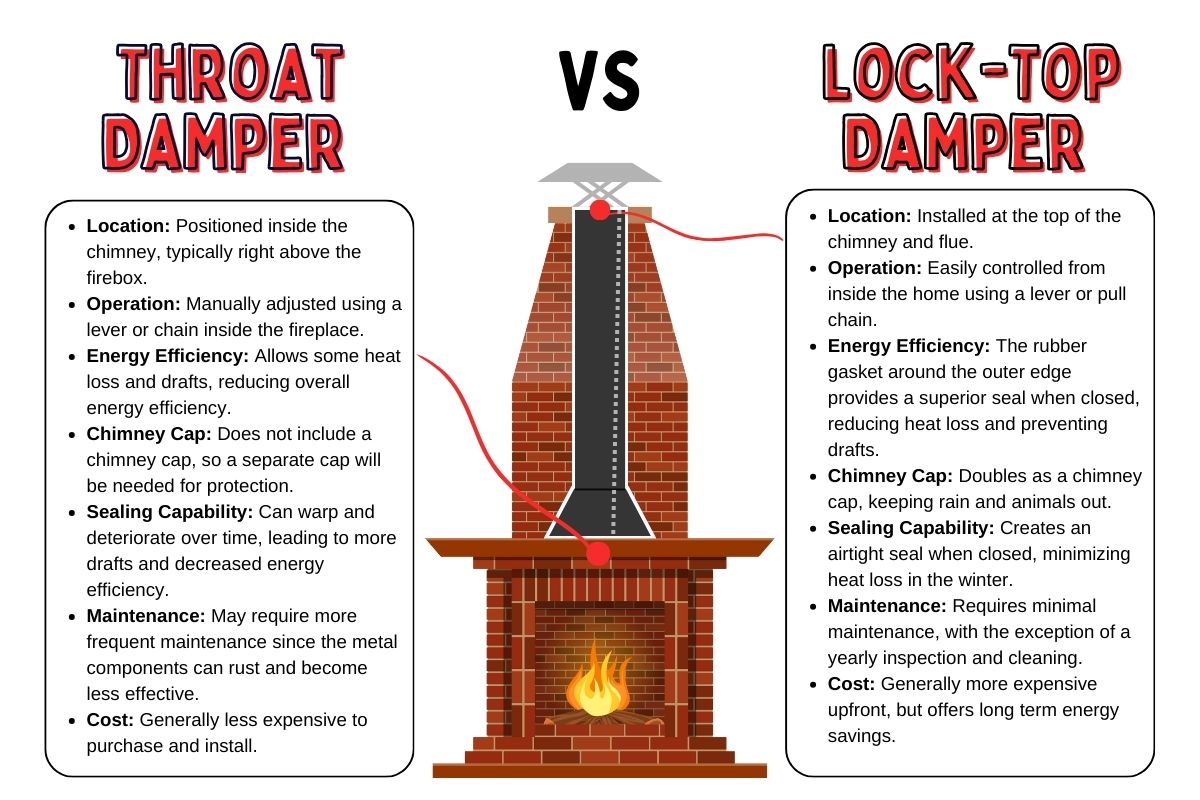Welcome to your crash course on chimney dampers! Maybe you’ve stumbled across this page because you’re tired of a drafty fireplace, or perhaps you’re in the process of building a new chimney and want to make sure you are picking the option that makes your fireplace the most efficient from the start.
Whatever the reason may be, Highpoint Chimney Services is here to provide you with a comprehensive comparison of lock-top dampers and throat dampers, so you have all the knowledge you need to make an informed decision on how to create the most enjoyable fireplace experience. Let’s jump right in and get you on your way to finding the perfect fit for your chimney.
Questions? Give us a call or reach out online. We’re here for you.

What Is a Chimney Throat Damper?
The most common type of damper is called a throat damper. In most masonry chimneys, they are located in the throat of the chimney, directly above the fireplace’s firebox. This is so they can be hidden for aesthetic purposes, but also remain accessible for you to operate fairly easily.
A throat damper is often made of a steel or cast iron handle and a metal plate that acts as a door between your chimney flue and the firebox. One of the problems with throat dampers is the heat from the fire can eventually warp them and make them completely useless.
So is there any reason you should consider a throat damper on your chimney? Yes, here are a few reasons why:
- Lower upfront costs: A throat damper is cheaper to replace compared to a lock-top damper. We know money is a huge factor when considering your options on chimney maintenance and repair. So, if budget is a primary concern, a throat damper can be a cost-effective option for you.
- Simple installation process: Because of their simplistic design and operation, throat dampers can be installed in various types of chimneys, including new construction and existing fireplaces.
- Traditional design: Throat dampers have been used for years which makes them widely available in many hardware stores and fireplace supply retailers. Most people are familiar with how they work and prefer to stick with a tried-and-true component for their chimney.
What Is a Lock-Top Chimney Damper?
Also called top sealing dampers or chimney cap dampers, these types of chimney dampers are not inside the chimney, but on top of the chimney. A lock-top damper has a spring-loaded door inside your chimney cap that is equipped with a silicone rubber gasket ring around the edge – this ensures an airtight seal. The ability to completely seal off the chimney from cold air blasts entering your home – and thus allow warm air to remain in your home – is what makes a lock-top damper the superior choice.
So, how else can you benefit from a lock-top damper?
- Improved energy efficiency: Have you ever sat by a fireplace and realized how drafty it can be? Whether or not your fireplace is in use, you want the warm air from your heater to stay inside your home. But if warm air is escaping out of the chimney and cold air is blowing in, you might find yourself cranking the thermostat. No one likes to see an increase in energy bills.
- Enhanced sealing: Not only does a lock-top damper seal out cold air in the winter and warm air in the summer, it also seals off the chimney from other threats. This reduces the risk of it being exposed to moisture, animals, or debris.
- Easy to use and maintain: Throat dampers are frequently exposed to high heat and this can cause them to warp over time. Not to mention, if they are ever exposed to moisture, dampers begin to rust and deteriorate quickly. While both types of chimney dampers require regular maintenance, a lock-top damper withstands the elements it is exposed to better, so it is less likely that you will experience problems with it.
Which Chimney Damper Type is Best?
Ultimately, the best damper type for you will depend on your specific needs, fireplace setup, and budget. Although throat dampers have been providing homeowners with adequate protection for years now, from a professional’s perspective, it’s worth mentioning that lock-top dampers are often favored for their air-tight sealing capabilities.
We’re Here to Help
If you’re having trouble with your throat damper or are ready to make the switch to a lock-top damper, give Highpoint Chimney Services a call today. You can either reach us at 908-864-4114 or schedule an appointment online. We look forward to helping you with all of your chimney and fireplace service needs.

Recent Comments